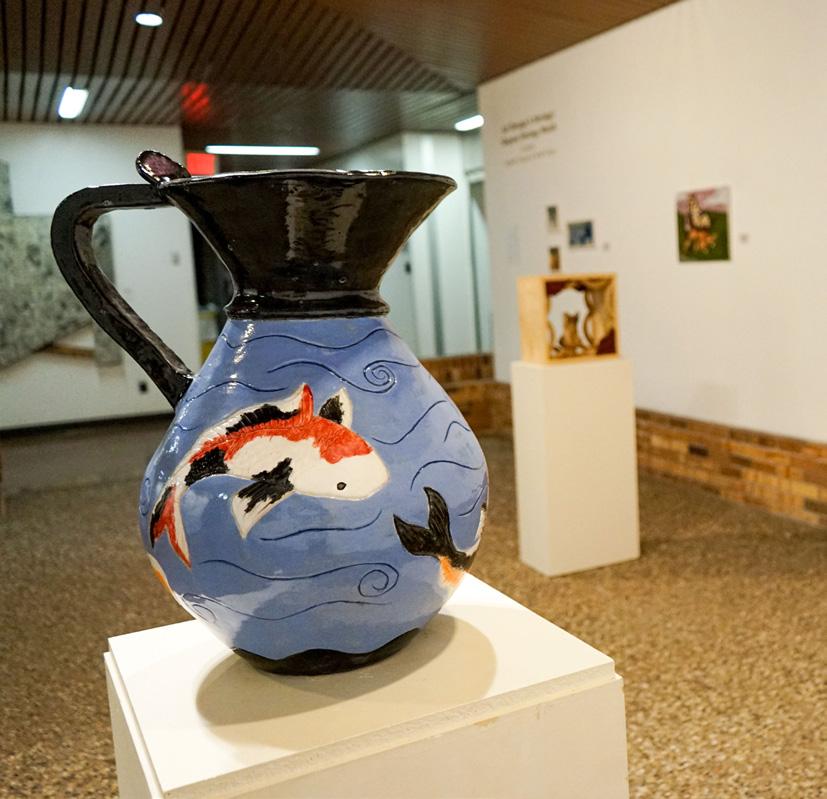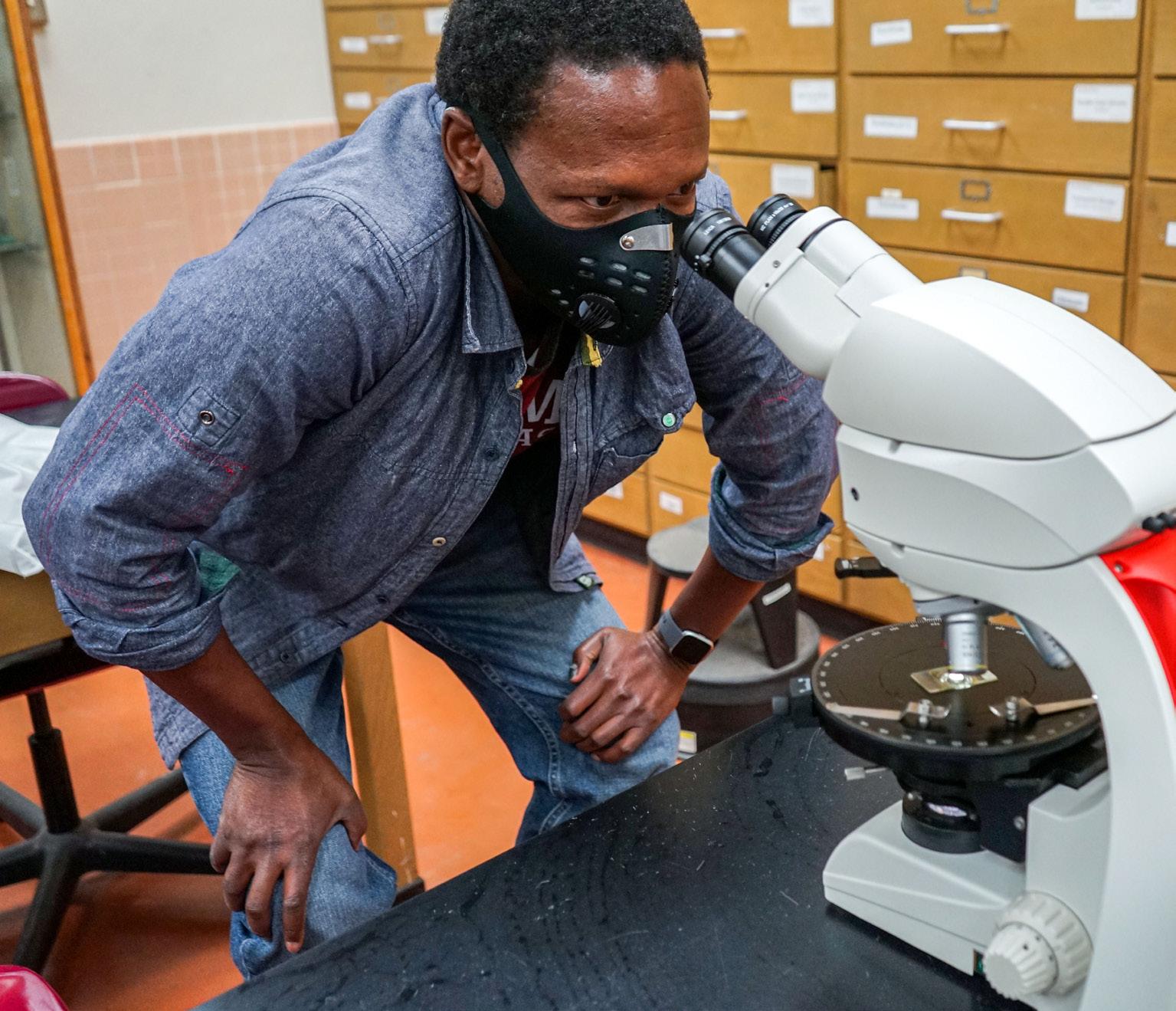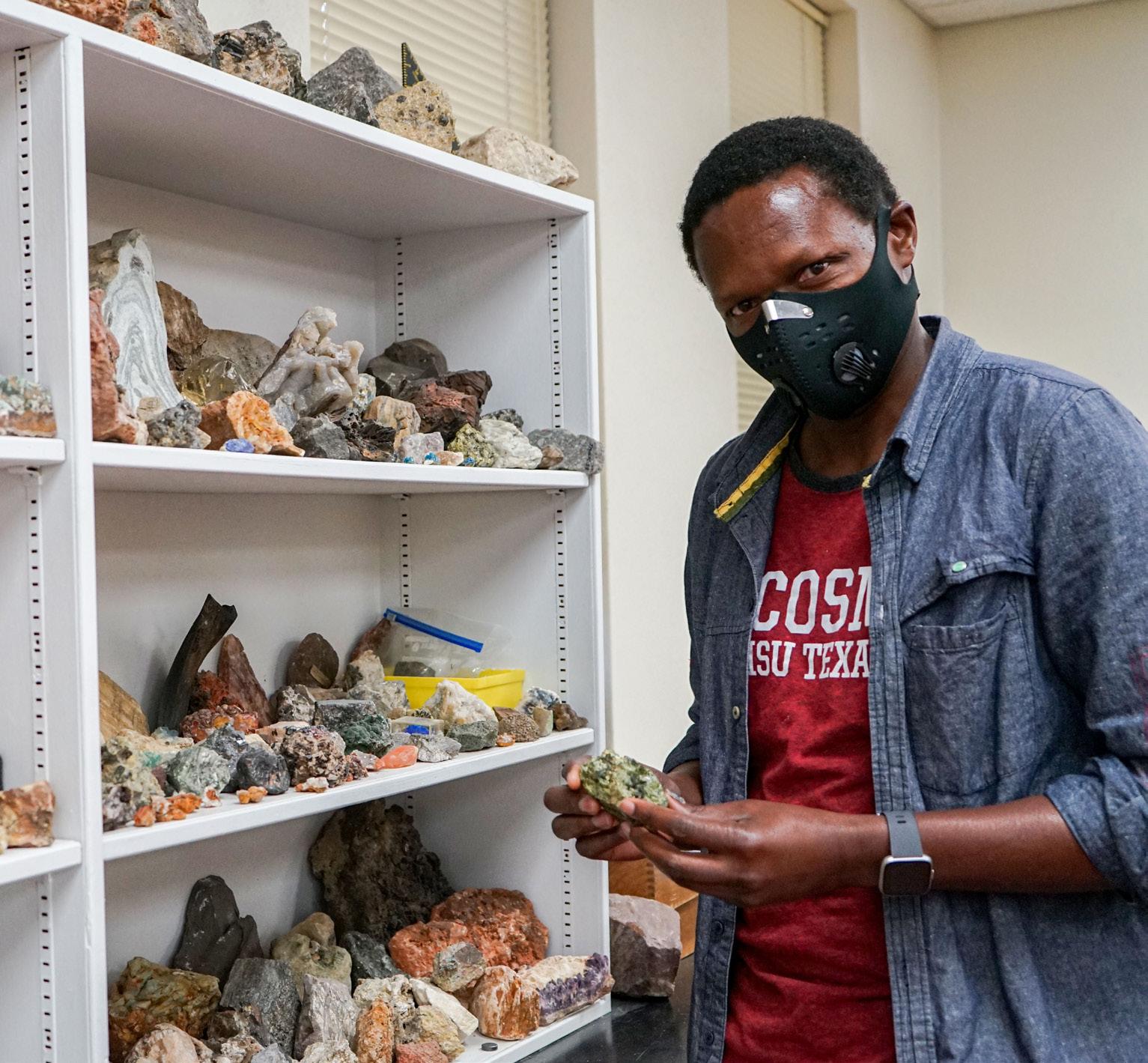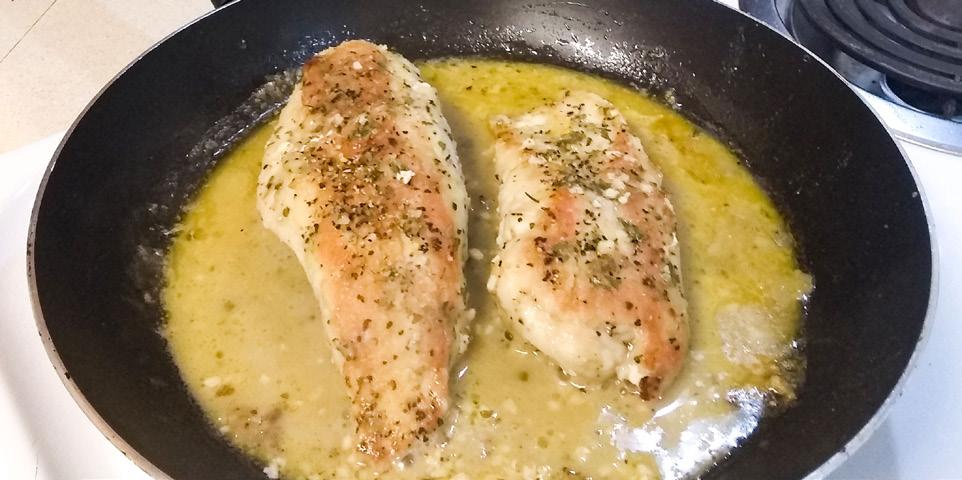
9 minute read
A VISUAL COMMEMORATION
HISPANIC HERITAGE MONTH: A VISUAL COMMEMORATION
Fine arts seniors Sapphire Vasquez and Sarah Grigeo display their art in the Juanita Harvey Art Gallery, Sept. 29.
PHOTO BY BRIDGET REILLY | THE WICHITAN
KHIRSTIA SHEFFIELD FEATURE EDITOR
As we slowly transition into a new season, Americans across the nation commemorate the contributions and influence of Hispanic Americans to the history, culture and achievements of the United States. Inspired by their culture, two students, Sapphire Vasquez, fine arts senior and Sarah Griego, fine arts senior, cultivated an art exhibition comprised of oil paintings, wooden sculptures and ceramics to pay homage to their ancestors and how far they have come.
“This curation, to me, reflects how I feel about my heritage,” said Vasquez. “It’s the art that came from people of Hispanic heritage. They’re all different, but together they show that even though we all have a similar heritage, we are all our own beings, as the art is too.”
Though Hispanic Heritage month is meant to bring individuals of the Hispanic culture together, Vasquez and Griego strived to create a masterpiece that relished in the beauty of artistic differences.
“We did not want to be restricted in gathering art that solely deals with what it means to be Hispanic,” said Griego. “We wanted to show

case the individuality of each artist.” lot of pressure because they only had two weeks and their art in order to even have an exhibi
Together Griego and Vasquez created six into finish this exhibition. tion,” said Griego. “We also realized how little dividual pieces. Griego’s pieces focused on oil “We were given two weeks to gather artists of a Hispanic community we have in our departpaintings and a collage that was comprised ment which was another challenge itself.” of mix medias. These pieces were named, “We had to juggle our other classes and “Los Herreras,” “Omar Apollo,” and “I’m Drained.” Vasquez’s pieces focused on oil paintings, a wooden sculpture and a ceramic vase. These pieces were named, “Rebirth and our jobs, so that was really a challenge,” said Vasquez. “But we got it done and I love it so much.” Transformation,” “Boni and the Plague,” and Despite the challenges they have faced, “Koi Fish Olpe.” they hope students and faculty of all back
“This exhibition means so much to me,” grounds can leave learning something new said Griego. “It has been an amazing opporabout the Hispanic culture, but also see the tunity for me to be a part of. I felt so honored beauty in their differences. and accomplished after creating this exhibi“I would like people to see the variety of tion. It is especially nice to be able to walk by talent that people of Hispanic decent have and see your work every day.” through their art,” said Vasquez. “We are
Art has been an integral part of each of our own individuals with a connection to their lives. From Vasquez following her father’s artistic footsteps to Griego becoming inspired by Instagram and Tumblr fan art. Art is their form of expression and through co-curating their first exhibition they have one another through our heritage, but it’s a reminder that we are so much more than our heritage. It’s just one component of our lives.” “I would love for people to just see how difcontinued to ignite their passion for telling a story through visuals. Although the end result is beautiful, Vasquez and Griego said they were under a PHOTO BY BRIDGET REILLY | THE WICHITAN A handmade sculpture by fine arts senior Sapphire Vasquez, Sept. 29. ferent art could be under the same ethnicity. All of the artists included in the gallery share a similar culture, but each piece is individual to them.”
GEOLOGY PROFESSOR RECEIVES GRANT TO CONDUCT THE FIRST RESEARCH COLLABORATION IN UGANDA

ed $184,066 toward research he is so passionate about, especially since it’s only his second year at MSU.
“It’s quite humbling. I didn’t even understand that these kinds of research aren’t that easy to get,” Katumwehe said. “It’s very competitive. It’s prestigious. It’s an honor to be given a grant within your first two years of academia.”
This research will focus on collaboration as Katumwehe will be working with six different universities as well as students from Uganda. He acknowledges that it will be a learning experience for everyone involved.
“I’m going to take these students from the U.S. to Africa so that they start understanding how different it can be,” Katumwehe said. “I want to see their reaction once they reach Africa and how they start looking at things they usually take for granted. They also get to conduct in research that they usually read in books, they can see it physically, they can relate to it and that’s going to be a monumental experience for them.”
Through the collaboration, Katumwehe believes this research will generate more understanding of the unique land of Uganda.
“We will come up with models, and those models will be used in areas that have undergone magma pour,” Katumwehe said. “They will be used to understand how all those rifts have been formed, and they will also be constructive in terms of understanding how rifting takes place without the presence of magma.”
Katumwehe hopes this research will positively impact the community.
“The models we come up with will shape how they continue their exploration,” Katumwehe said. “By understanding which areas have the tendency for movement, it will be able to help the community in coming up with designs for architecture.”
Despite his high hopes for this research, Katumwehe fears that this pandemic will put a halt to their plans. The research team plans to officially start the project by December, but in times like these nothing is set in stone.
PHOTO BY BRIDGET REILLY | THE WICHITAN Geology professor Andrew Katumwehe spends time looking through his microscope at an igneous rock, Sept. 29. KHIRSTIA SHEFFIELD you do for society, rather than impossible. FEATURE EDITOR G rowing up in Uganda, he watched his father’s face fill with excitewhat you have,” Katumwehe said. “I want to make sure my legacy is all about how much I have contributed to research. “I was always interested in the area where I was born, because it’s unique, and it’s different from how we underment as he told the stories of By taking this research prostand how continents break,” a mine in a coalfield. Strapped posal and this grant, it’s Katumwehe said. “It’s my for money, his father was humbling, because it’s my main thing; it’s my baby, and dedicated to making a betcontribution to the country people always asked why do I ter life for himself and he did [Uganda], my contribution to like this place, but [Uganda] just that. Discovering one gold research, and my contribution has recently formed about nugget changed his life, his to the U.S.” 3.7 billion barrels of oil in an family’s life, and molded AnKatumwehe has been pasarea that is least expected drew Katumwehe, assistant sionate about dry-rifting in to have oil. We all wanted to professor of geoscience, into Uganda since before obtainknow what is so special about the man he is today. Years ing his doctorate degree at this kind of setting, and when later, Katumwehe is followOklahoma State University. people started listening they ing in the footsteps of his faHe vividly remembers attendunderstood my concerns. They ther as he returns back to his ing tectonic meetings with bought into it, and that’s why home country after 14 years to graduate students and profesyou see they have put in that conduct a four-year study on sors where they discussed how kind of money to understand dry rifting in the Albertinecontinents are formed, how it.” Rhino Graben, with the help they move, and how they’ve After submitting his first of a $184,066 grant from the assembled. These discussions research proposal in March National Science Foundation. inspired him to look past the 2019, Katumwehe said he nev
“It’s always about what surface level and discover the er thought he would be grant

Sept. 30, 2020 Campus Voices | Black Student Union | Breonna Taylor | BLM | RBG | Media | News | Sports 13 LET’S CHAT: A BROKE STUDENT RECIPE: Lemon Pepper Chicken
COMING TO A DORM NEAR YOU
EMILY BEAMAN REPORTER
From Sept. 12 through Oct. 3, Midwestern State University’s Counseling Center is partnering up with Residence Life and Housing to trial a new wellness program called Let’s Chat.
Let’s Chat brings counselors directly to the lobbies of the dormitories on campus. It attempts to reduce geographic barriers for students seeking access to the campus mental health services.
The program occurs on Saturdays from 12 P.M. to 5 P.M. Counselors are available to talk to through this timeframe, but they provide no commitment nor confidential consultations.
“They’re not providing therapy services,” Zachary Zoet, the Licensed Practicing Counselor-Intern facilitating the program, said. “But they are able to help answer questions about the counseling center, mental health services, to chat with you or to listen about a problem or concern.”
Appointments aren’t necessary to receive the benefits provided by Let’s Chat.
“[The consultations] are first-come, first-serve,” Zoet said, “and are designed to be casual and drop-in by nature.”
Every session is different. With time and context being dependent on the student, sessions can vary from listening and providing support, answering questions about services, or providing strategies for dealing with test anxiety or homesickness.
“It’s a great resource to try and dip your toes into the waters of learning about mental health resources on campus,” Zoet said. “Or a good way to get a friend that information or potentially needed support.”
All dates, times and locations for Let’s Chat are available on MustangsLink.
The Counseling Center Hours: Monday through Friday 8A.M. to 5P.M.
JUST A SIMPLE CONVERSATION

Lemon pepper chicken.

PHOTO BY DALLAS WABBINGTON | THE WICHITAN
TDALLAS WABBINGTON | REPORTER his chicken recipe is simple and addicting. After I finished cooking, this dish made me wish I would have cooked with even more chicken, because it was too good to stop after two pieces.
INGREDIENTS: 1 pound chicken breasts 1 tablespoon lemon pepper seasoning 1/2 cup all-purpose flour 2 lemons 1/2 cup chicken broth 2 cloves garlic, minced 2 tablespoons butter 1 teaspoon salt 2 tablespoons extra-virgin olive oil 1/4 cup milk parsley, for garnish (optional)
STEPS: 1) In a bowl, mix together flour, lemon pepper, salt and zest from one lemon. Coat the chicken completely in the mixture and slice the remaining lemon into thin slices.
2) Heat oil in a skillet over medium-high heat and place chicken. Cook until each side is golden for about five minutes per side. 3) To the skillet, add broth, butter, garlic, lemon slices and a splash of milk (less than 1/4 cup). Cook until the chicken is cooked all the way and the sauce has reduced slightly, about 3 minutes. 4) Spoon the sauce onto the chicken and garnish with parsley.





